TRANSLATION STUDIES IN THE USA 1. Colonization, expansion,
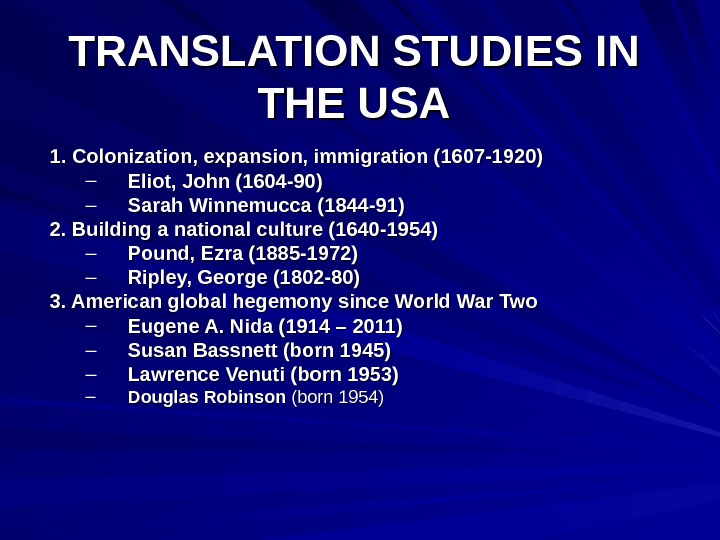


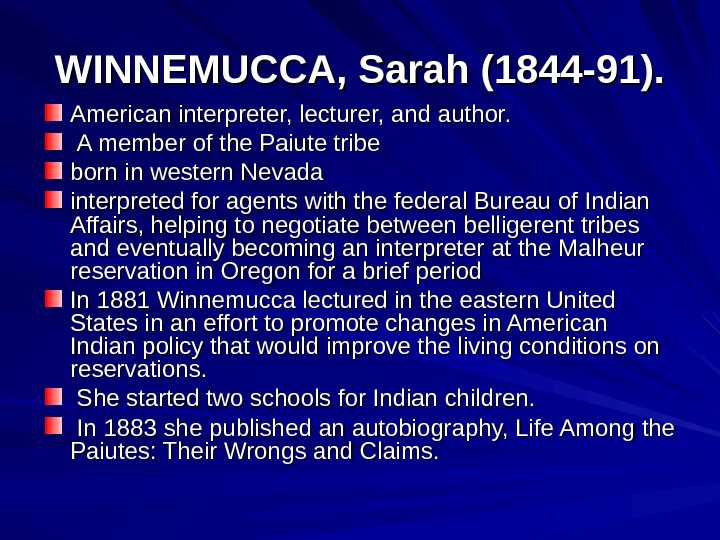
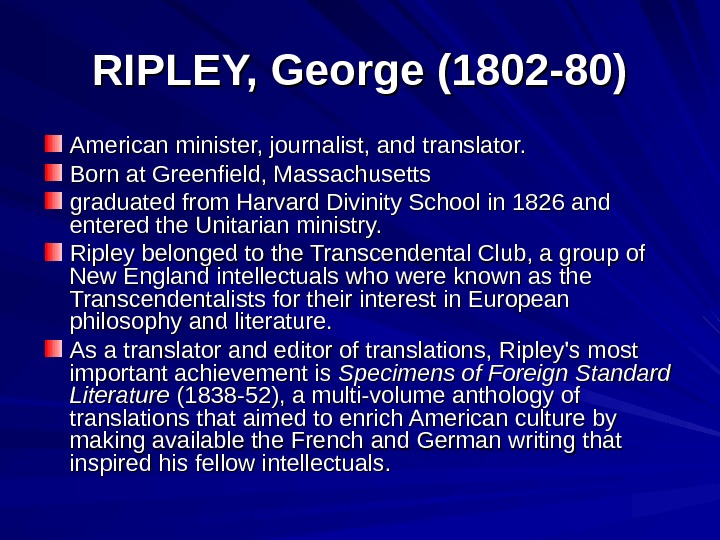
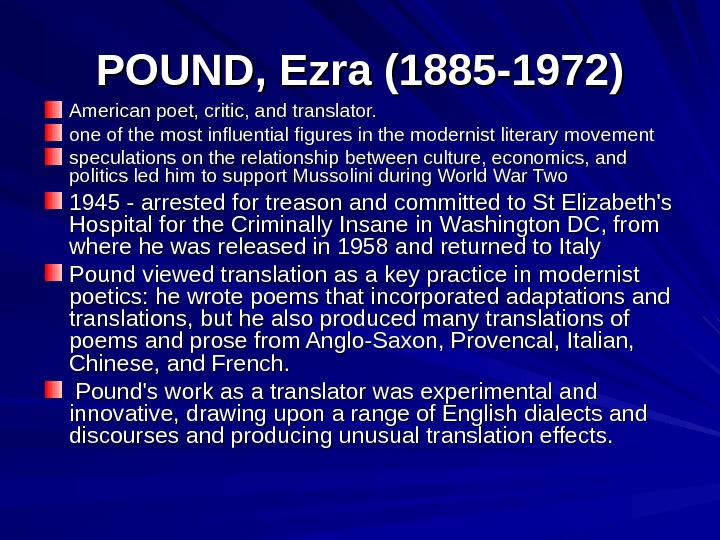

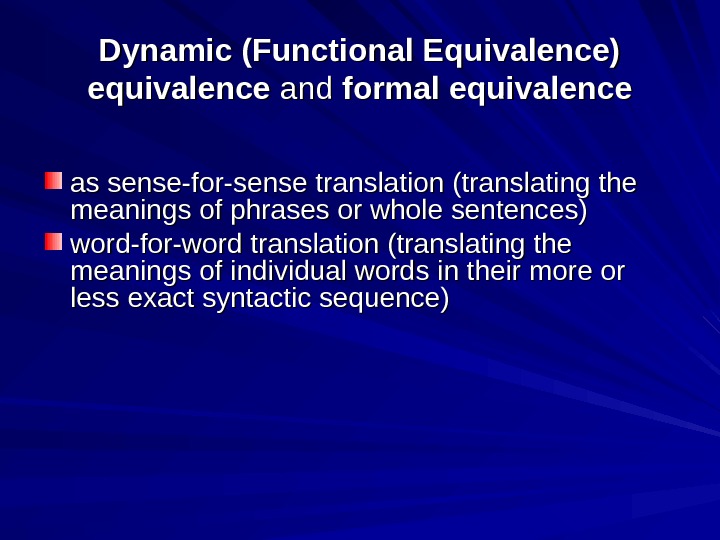
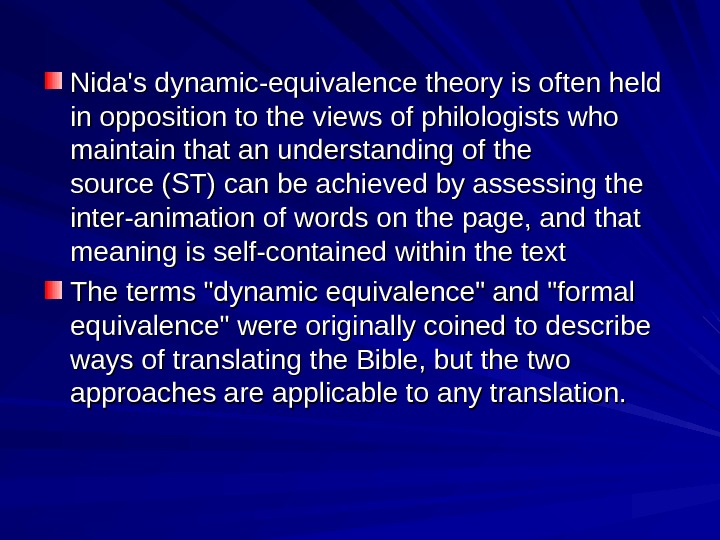

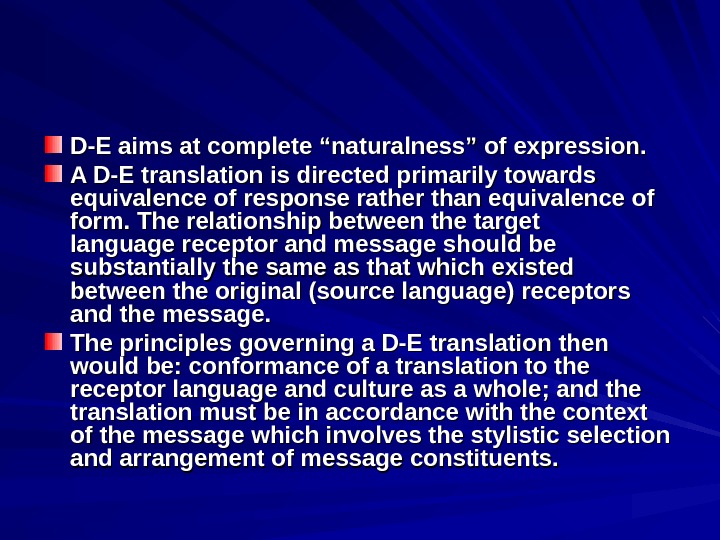
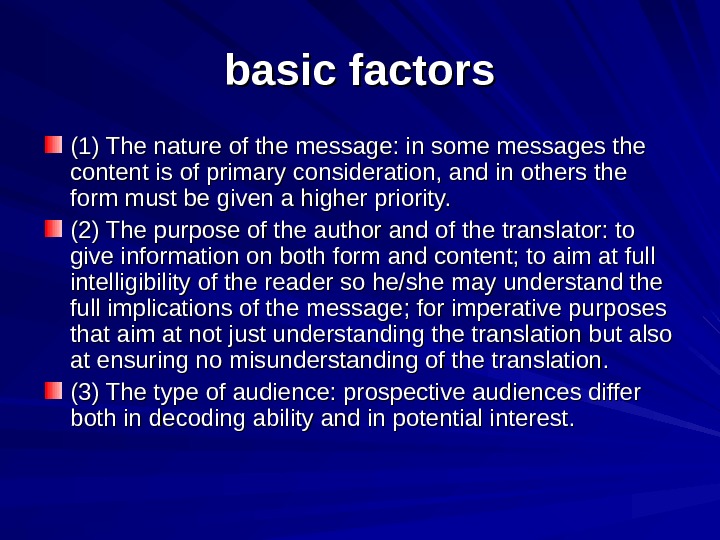
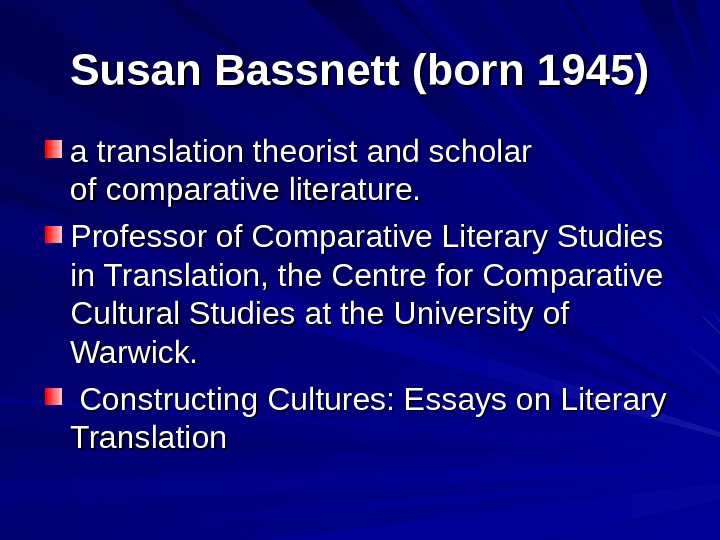



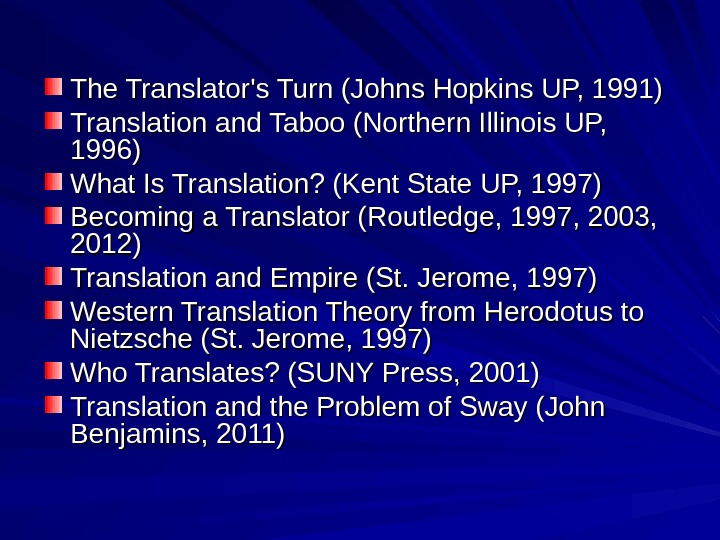
translation_studies_in_the_usa.ppt
- Размер: 228.5 Кб
- Количество слайдов: 17
Описание презентации TRANSLATION STUDIES IN THE USA 1. Colonization, expansion, по слайдам
 TRANSLATION STUDIES IN THE USA 1. Colonization, expansion, immigration (1607 -1920) – Eliot, John (1604 -90) – Sarah Winnemucca (1844 -91) 2. Building a national culture (1640 -1954) – Pound, Ezra (1885 -1972) – Ripley, George (1802 -80) 3. American global hegemony since World War Two – Eugene A. Nida (1914 – 2011) – Susan Bassnett (born 1945) – Lawrence Venuti (born 1953) – Douglas Robinson (born 1954)
TRANSLATION STUDIES IN THE USA 1. Colonization, expansion, immigration (1607 -1920) – Eliot, John (1604 -90) – Sarah Winnemucca (1844 -91) 2. Building a national culture (1640 -1954) – Pound, Ezra (1885 -1972) – Ripley, George (1802 -80) 3. American global hegemony since World War Two – Eugene A. Nida (1914 – 2011) – Susan Bassnett (born 1945) – Lawrence Venuti (born 1953) – Douglas Robinson (born 1954)
 Throughout. Americanhistory translation has been double-edged initssocial functions: translationenabledthe. United. Statestogrowinsizeand power: itmadepossiblethecolonization, dispossession, andassimilationofpeopleswhosenativelanguagewas not. English, anditcontinuestosupportthepoliticaland economichegemonythatthecountryhasenjoyedsince World. War. Two. translationcontributedtotheformationofadefinably Americanidentity: itwasinstrumentalinconstructinga nationalliteraryandpoliticaltradition, while simultaneouslyworkingtodiversify. Americancultureand toprecipitateculturalinnovationandsocialchange.
Throughout. Americanhistory translation has been double-edged initssocial functions: translationenabledthe. United. Statestogrowinsizeand power: itmadepossiblethecolonization, dispossession, andassimilationofpeopleswhosenativelanguagewas not. English, anditcontinuestosupportthepoliticaland economichegemonythatthecountryhasenjoyedsince World. War. Two. translationcontributedtotheformationofadefinably Americanidentity: itwasinstrumentalinconstructinga nationalliteraryandpoliticaltradition, while simultaneouslyworkingtodiversify. Americancultureand toprecipitateculturalinnovationandsocialchange.
 ELIOT, John (1604 -90) Englishminister, author, andtranslator. Hisreligiousviewswereless. Anglicanthan. Puritan, andin 1631 heleft. Englandforthecolonyin. Massachusetts, where hebecamepastorofthefirstchurchat. Cambridge. In 1640 Eliotcollaboratedontheinfluential. Englishtranslation ofthe. Psalmsknownas The Bay Psalm Book. Inthe 1640 s, withthehelpofanativeinformant, hestudied Indianlanguagesandembarkedonalife-longevangelical projectthatearnedhimthetitleof’Indian. Apostle’. Heestablishedmanysettlementsof. Indianswhomhenotonly convertedto. Christianity, butintroducedto. Englishculturaland socialpractices. In 1653 Eliotbegantowriteinthe. Algonquian language Healsopublishedmanualsof. Algonquian, designedfor missionariesaswellasnativeconverts.
ELIOT, John (1604 -90) Englishminister, author, andtranslator. Hisreligiousviewswereless. Anglicanthan. Puritan, andin 1631 heleft. Englandforthecolonyin. Massachusetts, where hebecamepastorofthefirstchurchat. Cambridge. In 1640 Eliotcollaboratedontheinfluential. Englishtranslation ofthe. Psalmsknownas The Bay Psalm Book. Inthe 1640 s, withthehelpofanativeinformant, hestudied Indianlanguagesandembarkedonalife-longevangelical projectthatearnedhimthetitleof’Indian. Apostle’. Heestablishedmanysettlementsof. Indianswhomhenotonly convertedto. Christianity, butintroducedto. Englishculturaland socialpractices. In 1653 Eliotbegantowriteinthe. Algonquian language Healsopublishedmanualsof. Algonquian, designedfor missionariesaswellasnativeconverts.
 WINNEMUCCA, Sarah (1844 -91). Americaninterpreter, lecturer, andauthor. Amemberofthe. Paiutetribe borninwestern. Nevada interpretedforagentswiththefederal. Bureauof. Indian Affairs, helpingtonegotiatebetweenbelligerenttribes andeventuallybecominganinterpreteratthe. Malheur reservationin. Oregonforabriefperiod In 1881 Winnemuccalecturedintheeastern. United Statesinanefforttopromotechangesin. American Indianpolicythatwouldimprovethelivingconditionson reservations. Shestartedtwoschoolsfor. Indianchildren. In 1883 shepublishedanautobiography, Life. Amongthe Paiutes: Their. Wrongsand. Claims.
WINNEMUCCA, Sarah (1844 -91). Americaninterpreter, lecturer, andauthor. Amemberofthe. Paiutetribe borninwestern. Nevada interpretedforagentswiththefederal. Bureauof. Indian Affairs, helpingtonegotiatebetweenbelligerenttribes andeventuallybecominganinterpreteratthe. Malheur reservationin. Oregonforabriefperiod In 1881 Winnemuccalecturedintheeastern. United Statesinanefforttopromotechangesin. American Indianpolicythatwouldimprovethelivingconditionson reservations. Shestartedtwoschoolsfor. Indianchildren. In 1883 shepublishedanautobiography, Life. Amongthe Paiutes: Their. Wrongsand. Claims.
 RIPLEY, George (1802 -80) Americanminister, journalist, andtranslator. Bornat. Greenfield, Massachusetts graduatedfrom. Harvard. Divinity. Schoolin 1826 and enteredthe. Unitarianministry. Ripleybelongedtothe. Transcendental. Club, agroupof New. Englandintellectualswhowereknownasthe Transcendentalistsfortheirinterestin. European philosophyandliterature. Asatranslatorandeditoroftranslations, Ripley’smost importantachievementis Specimens of Foreign Standard Literature (1838 -52), amulti-volumeanthologyof translationsthataimedtoenrich. Americancultureby makingavailablethe. Frenchand. Germanwritingthat inspiredhisfellowintellectuals.
RIPLEY, George (1802 -80) Americanminister, journalist, andtranslator. Bornat. Greenfield, Massachusetts graduatedfrom. Harvard. Divinity. Schoolin 1826 and enteredthe. Unitarianministry. Ripleybelongedtothe. Transcendental. Club, agroupof New. Englandintellectualswhowereknownasthe Transcendentalistsfortheirinterestin. European philosophyandliterature. Asatranslatorandeditoroftranslations, Ripley’smost importantachievementis Specimens of Foreign Standard Literature (1838 -52), amulti-volumeanthologyof translationsthataimedtoenrich. Americancultureby makingavailablethe. Frenchand. Germanwritingthat inspiredhisfellowintellectuals.
 POUND, Ezra (1885 -1972) Americanpoet, critic, andtranslator. oneofthemostinfluentialfiguresinthemodernistliterarymovement speculationsontherelationshipbetweenculture, economics, and politicsledhimtosupport. Mussoliniduring. World. War. Two 1945 -arrestedfortreasonandcommittedto. St. Elizabeth’s Hospitalforthe. Criminally. Insanein. Washington. DC, from wherehewasreleasedin 1958 andreturnedto. Italy Poundviewedtranslationasakeypracticeinmodernist poetics: hewrotepoemsthatincorporatedadaptationsand translations, buthealsoproducedmanytranslationsof poemsandprosefrom. Anglo-Saxon, Provencal, Italian, Chinese, and. French. Pound’sworkasatranslatorwasexperimentaland innovative, drawinguponarangeof. Englishdialectsand discoursesandproducingunusualtranslationeffects.
POUND, Ezra (1885 -1972) Americanpoet, critic, andtranslator. oneofthemostinfluentialfiguresinthemodernistliterarymovement speculationsontherelationshipbetweenculture, economics, and politicsledhimtosupport. Mussoliniduring. World. War. Two 1945 -arrestedfortreasonandcommittedto. St. Elizabeth’s Hospitalforthe. Criminally. Insanein. Washington. DC, from wherehewasreleasedin 1958 andreturnedto. Italy Poundviewedtranslationasakeypracticeinmodernist poetics: hewrotepoemsthatincorporatedadaptationsand translations, buthealsoproducedmanytranslationsof poemsandprosefrom. Anglo-Saxon, Provencal, Italian, Chinese, and. French. Pound’sworkasatranslatorwasexperimentaland innovative, drawinguponarangeof. Englishdialectsand discoursesandproducingunusualtranslationeffects.
 Eugene A. Nida (1914 – 2011) obtaineda. Master’s. Degreein. New Testament. Greekin 1939 1943, receivedhis. Ph. D. in. Linguistics fromthe. Universityof. Michigan wasinstrumentalinengineeringthejoint effortbetweenthe. Vaticanandthe. United Bible. Societies(UBS)toproduce cross-denominational. Biblesintranslations acrosstheglobe.
Eugene A. Nida (1914 – 2011) obtaineda. Master’s. Degreein. New Testament. Greekin 1939 1943, receivedhis. Ph. D. in. Linguistics fromthe. Universityof. Michigan wasinstrumentalinengineeringthejoint effortbetweenthe. Vaticanandthe. United Bible. Societies(UBS)toproduce cross-denominational. Biblesintranslations acrosstheglobe.
 Dynamic (Functional Equivalence) equivalence andand formal equivalence assense-for-sensetranslation(translatingthe meaningsofphrasesorwholesentences) word-for-wordtranslation(translatingthe meaningsofindividualwordsintheirmoreor lessexactsyntacticsequence)
Dynamic (Functional Equivalence) equivalence andand formal equivalence assense-for-sensetranslation(translatingthe meaningsofphrasesorwholesentences) word-for-wordtranslation(translatingthe meaningsofindividualwordsintheirmoreor lessexactsyntacticsequence)
 Nida’sdynamic-equivalencetheoryisoftenheld inoppositiontotheviewsofphilologistswho maintainthatanunderstandingofthe source(ST)canbeachievedbyassessingthe inter-animationofwordsonthepage, andthat meaningisself-containedwithinthetext Theterms»dynamicequivalence»and»formal equivalence»wereoriginallycoinedtodescribe waysoftranslatingthe. Bible, butthetwo approachesareapplicabletoanytranslation.
Nida’sdynamic-equivalencetheoryisoftenheld inoppositiontotheviewsofphilologistswho maintainthatanunderstandingofthe source(ST)canbeachievedbyassessingthe inter-animationofwordsonthepage, andthat meaningisself-containedwithinthetext Theterms»dynamicequivalence»and»formal equivalence»wereoriginallycoinedtodescribe waysoftranslatingthe. Bible, butthetwo approachesareapplicabletoanytranslation.
 Formal Equivalence (F-E) and Dynamic Equivalence (D-E) F-E focuses attention on the message itself, in both form and content. Such translations would be concerned with such correspondences as poetry to poetry, sentence to sentence, and concept to concept. Such a formal orientation that typifies this type of structural equivalence is called a “gloss translation” in which the translator aims at reproducing as literally and meaningfully as possible the form and content of the original. The principles governing an F-E translation would then be: reproduction of grammatical units; consistency in word usage; and meanings in terms of the source context.
Formal Equivalence (F-E) and Dynamic Equivalence (D-E) F-E focuses attention on the message itself, in both form and content. Such translations would be concerned with such correspondences as poetry to poetry, sentence to sentence, and concept to concept. Such a formal orientation that typifies this type of structural equivalence is called a “gloss translation” in which the translator aims at reproducing as literally and meaningfully as possible the form and content of the original. The principles governing an F-E translation would then be: reproduction of grammatical units; consistency in word usage; and meanings in terms of the source context.
 D-E aims at complete “naturalness” of expression. A D-E translation is directed primarily towards equivalence of response rather than equivalence of form. The relationship between the target language receptor and message should be substantially the same as that which existed between the original (source language) receptors and the message. The principles governing a D-E translation then would be: conformance of a translation to the receptor language and culture as a whole; and the translation must be in accordance with the context of the message which involves the stylistic selection and arrangement of message constituents.
D-E aims at complete “naturalness” of expression. A D-E translation is directed primarily towards equivalence of response rather than equivalence of form. The relationship between the target language receptor and message should be substantially the same as that which existed between the original (source language) receptors and the message. The principles governing a D-E translation then would be: conformance of a translation to the receptor language and culture as a whole; and the translation must be in accordance with the context of the message which involves the stylistic selection and arrangement of message constituents.
 basic factors (1)Thenatureofthemessage: insomemessagesthe contentisofprimaryconsideration, andinothersthe formmustbegivenahigherpriority. (2)Thepurposeoftheauthorandofthetranslator: to giveinformationonbothformandcontent; toaimatfull intelligibilityofthereadersohe/shemayunderstandthe fullimplicationsofthemessage; forimperativepurposes thataimatnotjustunderstandingthetranslationbutalso atensuringnomisunderstandingofthetranslation. (3)Thetypeofaudience: prospectiveaudiencesdiffer bothindecodingabilityandinpotentialinterest.
basic factors (1)Thenatureofthemessage: insomemessagesthe contentisofprimaryconsideration, andinothersthe formmustbegivenahigherpriority. (2)Thepurposeoftheauthorandofthetranslator: to giveinformationonbothformandcontent; toaimatfull intelligibilityofthereadersohe/shemayunderstandthe fullimplicationsofthemessage; forimperativepurposes thataimatnotjustunderstandingthetranslationbutalso atensuringnomisunderstandingofthetranslation. (3)Thetypeofaudience: prospectiveaudiencesdiffer bothindecodingabilityandinpotentialinterest.
 Susan Bassnett (born 1945) atranslationtheoristandscholar ofcomparativeliterature. Professorof. Comparative. Literary. Studies in. Translation, the. Centrefor. Comparative Cultural. Studiesatthe. Universityof Warwick. Constructing. Cultures: Essayson. Literary Translation
Susan Bassnett (born 1945) atranslationtheoristandscholar ofcomparativeliterature. Professorof. Comparative. Literary. Studies in. Translation, the. Centrefor. Comparative Cultural. Studiesatthe. Universityof Warwick. Constructing. Cultures: Essayson. Literary Translation
 Lawrence Venuti (born 1953) an. Americantranslationtheorist, translationhistorian, andatranslator from. Italian, French, and. Catalan. Rethinking. Translation: Discourse, Subjectivity, Ideology(anthology ofessays, editor)(1992) The. Translator’s. Invisibility: AHistoryof. Translation(1995) The. Scandalsof. Translation: Towardsan. Ethicsof Difference(1998). Encyclopediaof. Translation. Studies(1998)(contributor) Oxford. Guideto. Literaturein. English. Translation(2000)(contributor) The. Translation. Studies. Reader(3 rded. 2012)(asurveyof translationtheoryfromantiquitytothepresent; editor) Translation. Changes. Everything(2012)
Lawrence Venuti (born 1953) an. Americantranslationtheorist, translationhistorian, andatranslator from. Italian, French, and. Catalan. Rethinking. Translation: Discourse, Subjectivity, Ideology(anthology ofessays, editor)(1992) The. Translator’s. Invisibility: AHistoryof. Translation(1995) The. Scandalsof. Translation: Towardsan. Ethicsof Difference(1998). Encyclopediaof. Translation. Studies(1998)(contributor) Oxford. Guideto. Literaturein. English. Translation(2000)(contributor) The. Translation. Studies. Reader(3 rded. 2012)(asurveyof translationtheoryfromantiquitytothepresent; editor) Translation. Changes. Everything(2012)
 Douglas Robinson (born 1954) Americanacademicscholar, translator, andfiction-writer bestknownforhisworkintranslation studies
Douglas Robinson (born 1954) Americanacademicscholar, translator, andfiction-writer bestknownforhisworkintranslation studies
 Robinsoniscurrently. Deanofthe Arts. Facultyat. Hong. Kong. Baptist University
Robinsoniscurrently. Deanofthe Arts. Facultyat. Hong. Kong. Baptist University
 The. Translator’s. Turn(Johns. Hopkins. UP, 1991) Translationand. Taboo(Northern. Illinois. UP, 1996) What. Is. Translation? (Kent. State. UP, 1997) Becominga. Translator(Routledge, 1997, 2003, 2012) Translationand. Empire(St. Jerome, 1997) Western. Translation. Theoryfrom. Herodotusto Nietzsche(St. Jerome, 1997) Who. Translates? (SUNYPress, 2001) Translationandthe. Problemof. Sway(John Benjamins, 2011)
The. Translator’s. Turn(Johns. Hopkins. UP, 1991) Translationand. Taboo(Northern. Illinois. UP, 1996) What. Is. Translation? (Kent. State. UP, 1997) Becominga. Translator(Routledge, 1997, 2003, 2012) Translationand. Empire(St. Jerome, 1997) Western. Translation. Theoryfrom. Herodotusto Nietzsche(St. Jerome, 1997) Who. Translates? (SUNYPress, 2001) Translationandthe. Problemof. Sway(John Benjamins, 2011)
